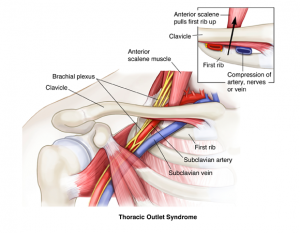What is Thoracic Outlet Syndrome?
The thoracic outlet is a small opening between the neck and shoulder that allows a variety of nerves and blood vessels to pass safely from the neck and supply the arm, chest and shoulder blade. As this can be quite a small space, any narrowing can cause these structures to become compressed and irritated. This phenomenon is commonly referred to as “Thoracic Outlet Syndrome”. This space can become compromised through trauma to the neck, overuse or repetitive stresses to the arm or the presence of an extra rib in the neck.
What are the signs and symptoms of Thoracic Outlet Syndrome?
Signs and symptoms of Thoracic Outlet Syndrome may depend on whether nervous tissue or blood vessels are involved. In most cases, symptoms will be caused by compression of nerve tissue rather than veins or arteries.
When neural tissue compression is the cause of the Thoracic Outlet Syndrome, reported symptoms may include pins and needles, tingling or numbness of the affected arm. Other symptoms include pain and weakness or tiredness of the arm that increases with work done overhead. Some people may experience neck pain or headaches in the base of their head.
If the vein is affected, there will be swelling and discoloration of the affected arm, as well as pain. When the artery is affected, cramping of the arm or hand during use may occur. Due to decreased blood flow, the arm or hand may feel cold and even change colour.
Who is usually affected?
It is common for people who work with their arms in an above-shoulder position to develop Thoracic Outlet Syndrome. For example, a teacher who writes frequently on a chalkboard, a construction worker hammering nails overhead, or a hairdresser.
How can physio help?
Your physiotherapist will assess a range of things including your posture, the flexibility of your spine, and length of your neck muscles. It is also important to assess the way you move your neck, back and arms.
Depending on the findings of the physical assessment, your physio will help you stretch appropriate muscles, assist with movement modification, and correct your posture. This may involve manual therapy techniques such as joint mobilizations, strapping techniques and soft tissue massage.
Treatment times may vary depending on symptom presentation and response, Thoracic Outlet Syndrome typically can take just a few treatments or several weeks to resolve as well as continuation of a home exercise program in order to resolve the issue.
None of the information in this article is a replacement for proper medical advice. Always see a medical professional for advice on your individual condition.
